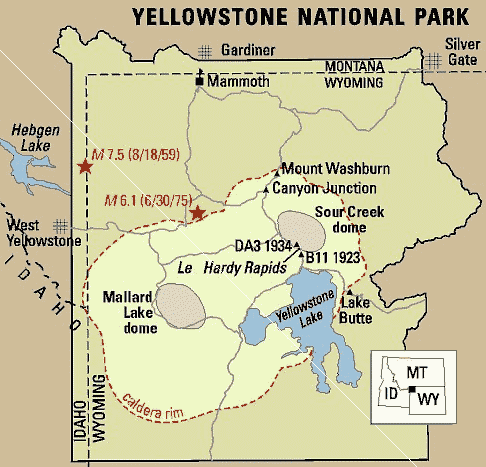our friendly neighbourhood super volcano
Photographer and Ucross residency coordinator Deborah Ford confirmed all the wild geological theories I came up with on Sunday at dinner tonight. Yes, those were volcanic rocks. Yes, those were petrified trees! I had a pretty clear idea of how the trees got petrified, but where did those lava boulders come from?
Well. It turns out that one of the largest super volcanoes in the world is sitting about 200 miles from here underneath Yellowstone National Park. A massive eruption there 2.1 million years ago left a gigantic caldera larger than the state of Rhode Island and hundreds of meters deep. Ground-hugging flows of hot volcanic ash, pumice, and gases swept across an area of more than 3,000 square miles and volume of about 1,000 cubic kilometres, enough material to cover Wyoming with a layer 13 feet thick. The eruption also shot a column of volcanic ash and gases high into Earth's stratosphere. This volcanic cloud circled the globe many times and affected Earth's climate by reducing the intensity of solar radiation reaching the lower atmosphere and surface. The fine volcanic ash that fell downwind from the eruption site blanketed much of North America and is still preserved in deposits as far away as Iowa, where it is a few inches thick, and the Gulf of Mexico, where it is recognizable in drill cores from the sea floor.
Subsequent smaller lava flows have since buried and obscured most of the caldera, but the underlying processes responsible for Yellowstone's tremendous volcanic eruptions are still at work. Volcanologists tracking the movement of magma under the park have calculated that in parts of Yellowstone the ground has risen over seventy centimetres the past century. The Yellowstone super volcano has been on a regular eruption cycle of 600,000 years. The last eruption was 640,000 years ago. The next is overdue. But I leave Wyoming December 8, so I'll probably miss it. In Montréal all we'll still see is fallout, toxic gas and ash.

. . . . .
Well. It turns out that one of the largest super volcanoes in the world is sitting about 200 miles from here underneath Yellowstone National Park. A massive eruption there 2.1 million years ago left a gigantic caldera larger than the state of Rhode Island and hundreds of meters deep. Ground-hugging flows of hot volcanic ash, pumice, and gases swept across an area of more than 3,000 square miles and volume of about 1,000 cubic kilometres, enough material to cover Wyoming with a layer 13 feet thick. The eruption also shot a column of volcanic ash and gases high into Earth's stratosphere. This volcanic cloud circled the globe many times and affected Earth's climate by reducing the intensity of solar radiation reaching the lower atmosphere and surface. The fine volcanic ash that fell downwind from the eruption site blanketed much of North America and is still preserved in deposits as far away as Iowa, where it is a few inches thick, and the Gulf of Mexico, where it is recognizable in drill cores from the sea floor.
Subsequent smaller lava flows have since buried and obscured most of the caldera, but the underlying processes responsible for Yellowstone's tremendous volcanic eruptions are still at work. Volcanologists tracking the movement of magma under the park have calculated that in parts of Yellowstone the ground has risen over seventy centimetres the past century. The Yellowstone super volcano has been on a regular eruption cycle of 600,000 years. The last eruption was 640,000 years ago. The next is overdue. But I leave Wyoming December 8, so I'll probably miss it. In Montréal all we'll still see is fallout, toxic gas and ash.

. . . . .
Labels: Ucross


0 Comments:
Post a Comment
<< Home